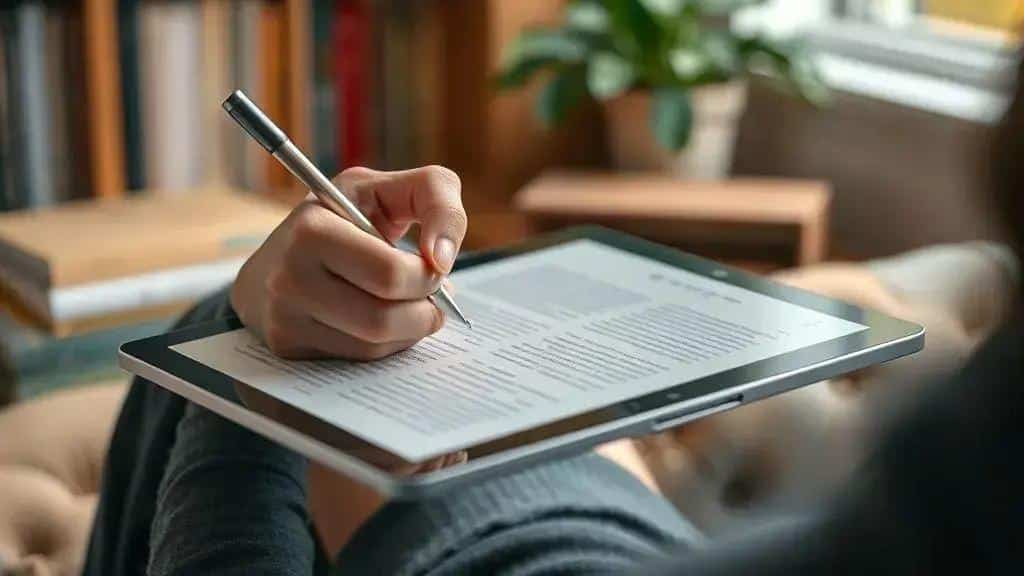Note-taking tools that will change your productivity

Effective note-taking tools enhance learning by helping students organize information, utilize strategies like the Cornell Method, and incorporate both digital and traditional methods for optimal retention.
Note-taking tools have become essential in today’s fast-paced world, helping individuals keep track of ideas and information. Ever wondered how the right tool can enhance your productivity? Let’s dive into the various options that can transform your note-taking experience.
Understanding the importance of note-taking
Understanding the importance of note-taking is crucial for anyone looking to enhance their learning and organization. Note-taking helps to capture ideas, thoughts, and key information. By writing things down, you not only retain information better but also clarify your thoughts. This clarity is essential for effective communication and problem-solving.
Benefits of Effective Note-Taking
Effective note-taking empowers you to become more productive. It helps in organizing information in a way that makes it easier to recall later. Additionally, taking notes during lectures, meetings, or while reading enhances active engagement with the material.
- Improves memory retention
- Enhances understanding of complex topics
- Promotes focus during learning
- Facilitates review and revision
Another significant aspect is how it contributes to better time management. With clear notes, you can quickly reference important details without having to re-read entire texts. This process can save you valuable time, especially during exam preparation or project deadlines.
Different Methods of Note-Taking
There are various methods of note-taking that can cater to different learning styles. For example, the Cornell method allows you to divide your notes into summaries, cues, and details. This structured approach helps to reinforce memory and comprehension.
- Cornell Method: A structured layout for reviewing
- Mapping: Visual representation of information
- Outline Method: Hierarchical organization of topics
- Charting: Comparing and contrasting different elements
Choosing the right method can make a significant difference in how effectively you absorb information. Experimenting with different styles can lead to finding the one that works best for you.
Ultimately, the practice of note-taking fosters a proactive learning environment. It transforms passive reading into active engagement, allowing for deeper comprehension and long-term retention of knowledge.
Top note-taking tools for students

When it comes to finding the top note-taking tools for students, the options are vast and varied. Each tool offers unique features designed to suit different learning styles and preferences. Whether you prefer digital or traditional methods, the right tools can enhance your study experience and help you stay organized.
Popular Digital Note-Taking Tools
Many students are turning to digital options for their note-taking needs due to their convenience and functionality. Apps like Notion, Evernote, and OneNote have gained popularity for their versatility.
- Notion: A flexible workspace that allows for organized notes, task management, and database creation.
- Evernote: Perfect for clipping web pages and organizing notes into notebooks for easy retrieval.
- OneNote: Integrates easily with other Microsoft products and allows handwritten notes along with typed entries.
Each of these tools provides options for organizing notes, which can lead to better information retention. They also enable easy sharing of notes, which can be helpful for group projects and study sessions.
Benefits of Using Note-Taking Apps
Note-taking apps offer several advantages over traditional pen and paper. For instance, they enable quick search options, allowing you to find information with just a few clicks. You can also sync your notes across multiple devices, ensuring you have access whenever you need them.
- Accessibility: Access your notes from any device, anywhere.
- Collaboration: Share notes and collaborate in real-time with classmates.
- Multimedia Integration: Add images, links, and audio to your notes for a richer experience.
Furthermore, the use of color coding, tags, and templates can make notes visually appealing and easier to navigate. This organization aids in effective studying and exam preparation.
While digital tools are beneficial, some students still prefer traditional methods such as notebooks and binders. These methods allow for a tactile learning experience, which can also enhance memory and retention.
Choosing the Right Tool for You
Deciding on the best note-taking tools depends on your personal learning style. Experimenting with both digital and traditional methods can help you identify what works best for you. Consider factors such as ease of use, accessibility, and the specific features that are essential for your studies.
Finding the right tools can significantly impact your academic performance and overall organization. With the right approach, note-taking can not only improve your grades but also make learning more enjoyable.
How to choose a note-taking tool that fits your needs
Choosing the right note-taking tool can greatly enhance your study experience. With so many options available, it’s important to consider what features meet your specific needs. Start by identifying your learning style, as this can guide your decision.
Assess Your Needs
Consider what you need in a note-taking tool. Are you looking for something digital or traditional? Do you prefer handwriting or typing? Understanding how you learn best will help narrow down your choices.
- Digital tools: Great for those who want to access notes from multiple devices.
- Physical notebooks: Ideal for students who retain information better through writing.
- Hybrid options: Some tools combine both digital and manual methods, providing versatility.
Next, think about the features you want. Some users need collaboration options, while others may need advanced organizational tools like tags or folders. Make a list of must-have features and nice-to-haves.
Try Before You Buy
Many note-taking applications offer free trials. Use this opportunity to explore the interface and see if it fits your workflow. Pay attention to how easy it is to create and organize notes.
- Test compatibility: Ensure the tool works well with your devices.
- Check for user support: Look for tutorials and help sections.
- Explore customization: See if you can personalize the layout and design.
Talking to classmates or friends about their experiences can also provide valuable insights. They might recommend tools you haven’t considered or share tips on how to use certain features effectively. The idea is to find a tool that feels comfortable and enhances your ability to retain information.
Finally, once you choose a tool, give yourself time to adjust. It may take a while to adapt to new features or layouts, but practicing consistently will make note-taking more efficient in the long run. Remember that the goal is not just to take notes but to create a system that supports your learning journey.
Tips for effective note-taking strategies

Effective note-taking strategies can make a big difference in how well you understand and retain information. Using the right techniques can lead to better organization and recall. Here are some techniques that can enhance your note-taking skills.
Use Abbreviations and Symbols
One way to take notes quickly is by using abbreviations and symbols. This allows you to write faster and catch essential points without losing focus. For example, use “&” for “and” or symbols like “➔” to show a cause and effect relationship.
- Develop your own system: Create symbols that make sense to you.
- Keep it consistent: Use the same symbols throughout your notes.
- Practice: Start using these in your classes to get comfortable.
Using such shortcuts can help you keep track of lectures or readings more efficiently.
Highlight Key Information
Another effective strategy is to highlight or underline key information. This makes it easier to identify important points when reviewing your notes later. Use different colors for various themes or subjects to organize your information visually.
- Choose a color scheme: For example, use blue for definitions, yellow for examples, and pink for important dates.
- Limit your highlights: Only highlight crucial ideas to avoid clutter.
- Use sticky notes: Add notes in the margins for extra clarification.
Highlighting not only draws your attention but also helps in retaining information better during study sessions.
Employ the Cornell Method
The Cornell Method is a structured way to take notes that aids in understanding and retention. Divide your paper into three sections: cues, notes, and summary. Use the notes section during lectures, write cues to trigger memory, and summarize main ideas at the bottom.
- Organized format: This layout keeps your notes clean and easy to navigate.
- Focus on questions: Use the cue section to write questions based on your notes.
- Review regularly: Summarizing helps reinforce what you’ve learned.
Implementing the Cornell Method can lead to a deeper comprehension of the material and prepare you better for exams.
Finally, always review your notes after class. This practice reinforces what you learned and helps identify areas that need more attention. By taking the time to evaluate your notes and ask questions, you make your learning experience more effective.
In summary, improving your note-taking skills can significantly enhance your learning experience. By using effective strategies, you can keep your notes organized and accessible. Remember to assess your needs and experiment with different tools to find what works best for you. Highlighting key points and using techniques like the Cornell Method can make a big difference. With practice, you’ll be able to take notes that help you learn better and remember information longer.
FAQ – Frequently Asked Questions about Note-Taking Tools and Strategies
What are some effective note-taking strategies?
Some effective strategies include using abbreviations, highlighting key points, and employing the Cornell Method for better organization.
How do I choose the right note-taking tool?
Assess your needs, consider whether you prefer digital or traditional methods, and experiment with different tools to find the best fit for you.
Why is regular review of notes important?
Regularly reviewing your notes reinforces learning and helps improve retention of information over time.
Can I use both digital and physical note-taking methods?
Yes, many students find success in combining both methods to take advantage of the strengths of each.





